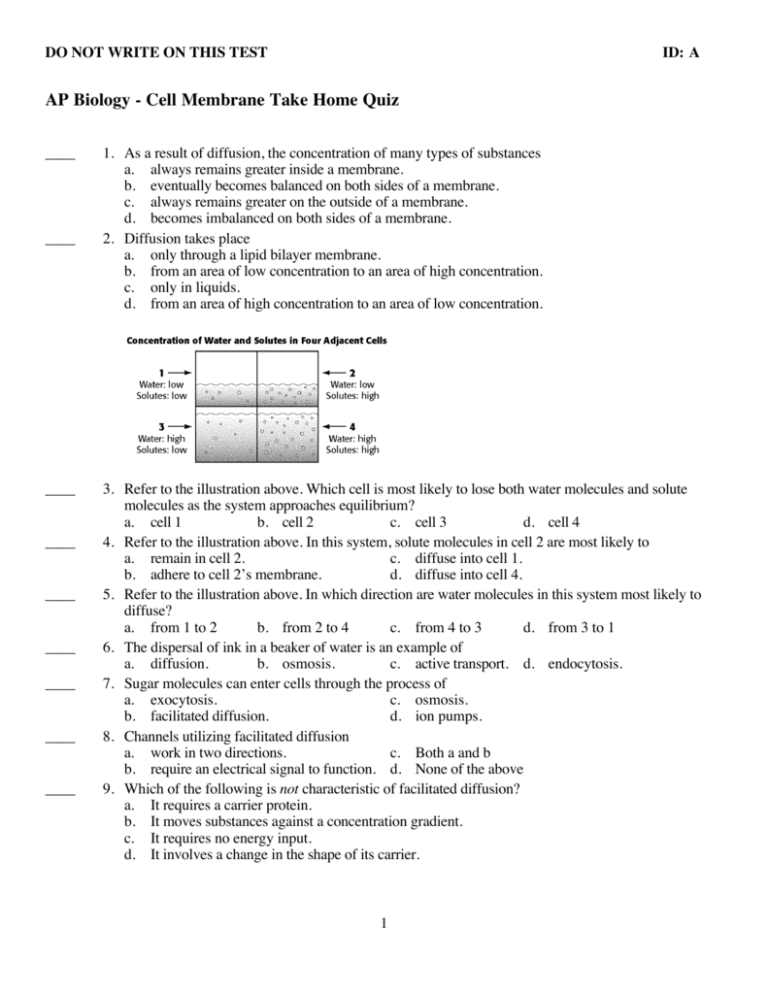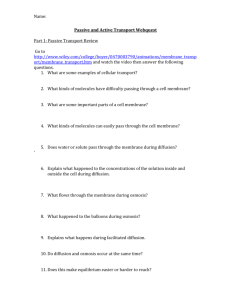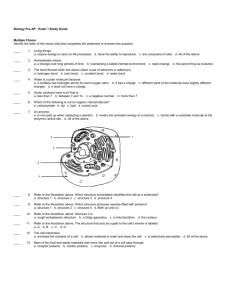AP Biology - Cell Membrane Take Home Quiz
advertisement

DO NOT WRITE ON THIS TEST ID: A AP Biology - Cell Membrane Take Home Quiz ____ ____ ____ ____ ____ ____ ____ ____ ____ 1. As a result of diffusion, the concentration of many types of substances a. always remains greater inside a membrane. b. eventually becomes balanced on both sides of a membrane. c. always remains greater on the outside of a membrane. d. becomes imbalanced on both sides of a membrane. 2. Diffusion takes place a. only through a lipid bilayer membrane. b. from an area of low concentration to an area of high concentration. c. only in liquids. d. from an area of high concentration to an area of low concentration. 3. Refer to the illustration above. Which cell is most likely to lose both water molecules and solute molecules as the system approaches equilibrium? a. cell 1 b. cell 2 c. cell 3 d. cell 4 4. Refer to the illustration above. In this system, solute molecules in cell 2 are most likely to a. remain in cell 2. c. diffuse into cell 1. b. adhere to cell 2’s membrane. d. diffuse into cell 4. 5. Refer to the illustration above. In which direction are water molecules in this system most likely to diffuse? a. from 1 to 2 b. from 2 to 4 c. from 4 to 3 d. from 3 to 1 6. The dispersal of ink in a beaker of water is an example of a. diffusion. b. osmosis. c. active transport. d. endocytosis. 7. Sugar molecules can enter cells through the process of a. exocytosis. c. osmosis. b. facilitated diffusion. d. ion pumps. 8. Channels utilizing facilitated diffusion a. work in two directions. c. Both a and b b. require an electrical signal to function. d. None of the above 9. Which of the following is not characteristic of facilitated diffusion? a. It requires a carrier protein. b. It moves substances against a concentration gradient. c. It requires no energy input. d. It involves a change in the shape of its carrier. 1 ID: A ____ ____ ____ ____ ____ 10. Which of the following is true of ions and their transport across cell membranes? a. The “gates” for ion channels are always open. b. Ion channels always allow any type of ion to pass through them. c. Electrical or chemical signals may control the movement of ions across cell membranes. d. Because they are charged particles, the movement of ions across cell membranes requires energy input. 11. Which of the following does not expend energy? a. diffusion c. active transport b. endocytosis d. a sodium-potassium pump 12. Which of the following enters a cell by active transport? a. glucose b. water c. lactose d. potassium ion 13. The process by which water passes into or out of a cell is called a. solubility. c. selective transport. b. osmosis. d. endocytosis. 14. ____ 15. ____ 16. ____ 17. ____ 18. ____ 19. ____ 20. Refer to the illustration above. The process shown is called a. osmosis. c. active transport. b. facilitated diffusion. d. diffusion. The sodium-potassium pump usually pumps a. potassium out of the cell. b. sodium into the cell. c. potassium into the cell. d. only a potassium and sugar molecule together. Ridding the cell of material by discharging it from sacs at the cell surface is called a. pinocytosis. b. phagocytosis. c. exocytosis. d. endocytosis. Molecules that are too large to be moved across a cell membrane can be removed from the cell by a. diffusion. b. exocytosis. c. lipid carriers. d. osmosis. Molecules that are too large to be moved through the membrane can be transported into the cell by a. osmosis. b. endocytosis. c. lipid carriers. d. diffusion. Placing a plant into a hypertonic environment will a. cause turgor pressure to increase. c. have no effect. b. cause the plant to take in water. d. cause turgor pressure to decrease. A calcium ion channel will allow a. any kind of ion to pass through it. c. positive ions to pass through it. b. only calcium ions to pass through it. d. None of the above 2










